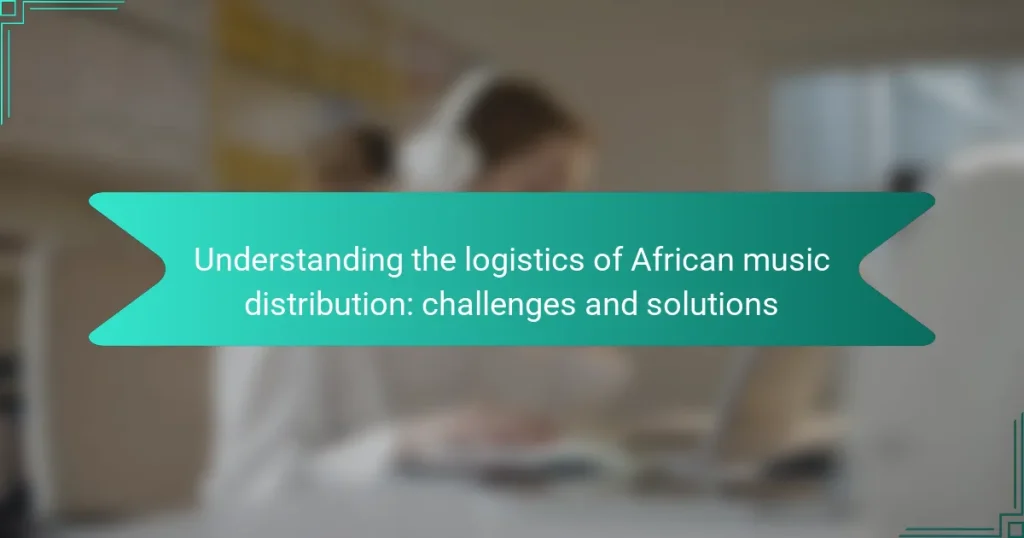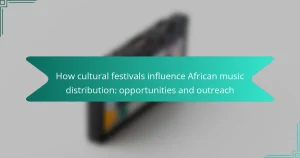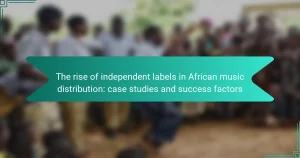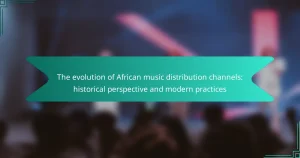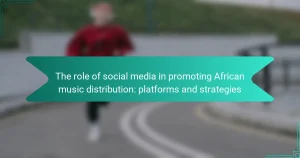African music distribution logistics encompass the processes and systems that deliver music to audiences both within the continent and globally. Key components include digital platforms such as Spotify and Apple Music, physical distribution channels through local record labels, and partnerships with local promoters. The article explores the challenges faced in this distribution, including inconsistent internet access, piracy issues, and diverse regulatory environments. It also highlights solutions such as leveraging mobile technology and community initiatives to enhance distribution effectiveness. Understanding these logistics is crucial for artists to maximize their reach and revenue while promoting cultural exchange and supporting the sustainability of the African music industry.
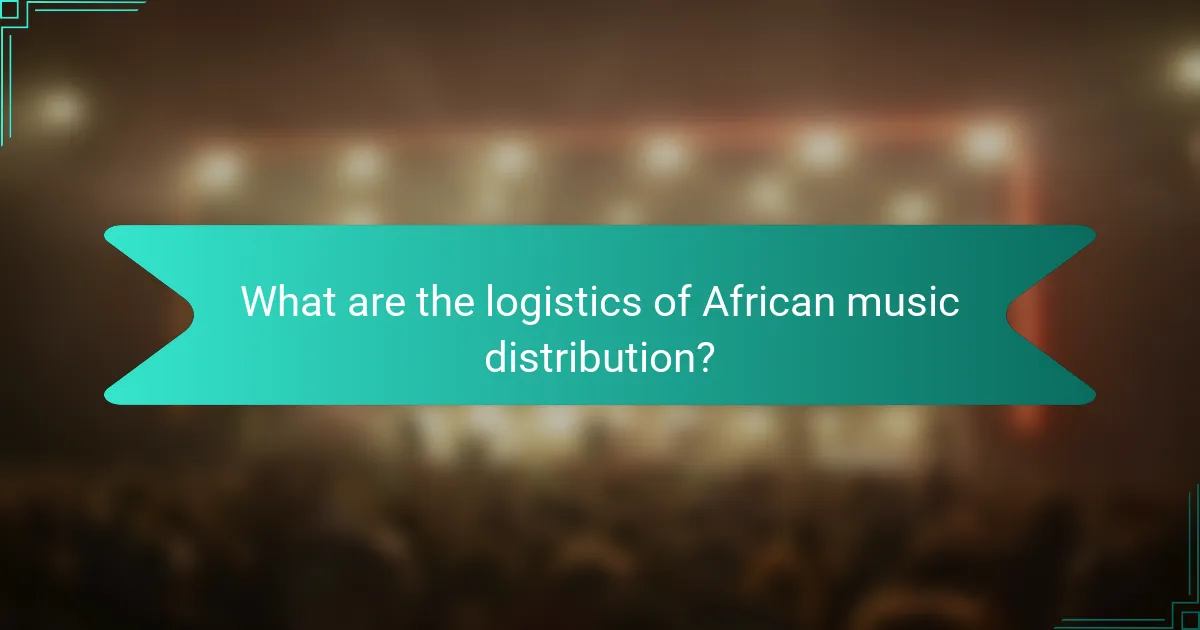
What are the logistics of African music distribution?
African music distribution logistics involve the processes and systems used to deliver music to audiences across the continent and globally. Key components include digital platforms, physical distribution channels, and local partnerships. Digital platforms like Spotify and Apple Music facilitate access to music but may have limited reach in rural areas. Physical distribution often relies on local record labels and distributors to reach markets where digital access is low. Additionally, artists frequently collaborate with local promoters and event organizers to enhance visibility. The logistics must also navigate diverse regulatory environments across different countries. Challenges include inconsistent internet access and piracy issues. Solutions often involve leveraging mobile technology and community-based initiatives to improve distribution effectiveness.
How do traditional and digital platforms differ in music distribution?
Traditional and digital platforms differ significantly in music distribution. Traditional platforms include physical media like vinyl, CDs, and cassettes. These formats require manufacturing, packaging, and shipping, which can be costly and time-consuming. Distribution is often limited to specific retail locations. In contrast, digital platforms distribute music via the internet. This allows for instantaneous access to a global audience. Digital distribution eliminates physical production costs and enables artists to reach listeners directly. According to the International Federation of the Phonographic Industry (IFPI), digital music revenues surpassed physical sales for the first time in 2015. This shift highlights the growing importance of digital platforms in the music industry.
What roles do record labels play in distribution?
Record labels play a crucial role in the distribution of music. They manage the logistics of getting music to market. This includes negotiating with digital platforms and physical retailers. Record labels also handle the promotion of music releases. They ensure that music reaches a wider audience through marketing strategies. Additionally, labels provide financial support for production and distribution costs. They often have established relationships with distributors and retailers. This network facilitates smoother distribution processes. According to the International Federation of the Phonographic Industry, record labels significantly impact music sales and streaming.
How has technology changed the landscape of music distribution?
Technology has transformed music distribution by enabling digital platforms for easier access and global reach. Streaming services like Spotify and Apple Music allow artists to distribute music directly to listeners. This shift reduces reliance on traditional record labels. It also lowers the costs associated with physical distribution. Digital downloads and streaming have surpassed physical sales in revenue. In 2020, streaming accounted for 83% of the U.S. music industry’s revenue. Social media platforms have also become vital for promotion and audience engagement. Artists can now connect directly with fans, bypassing traditional marketing channels. Overall, technology has democratized music distribution, empowering independent artists and expanding their audience.
What are the key challenges faced in African music distribution?
Key challenges in African music distribution include limited access to digital platforms. Many artists struggle with internet connectivity issues. This affects their ability to reach wider audiences. Additionally, there are insufficient local distribution channels. This leads to dependency on foreign platforms that may not prioritize African music. Legal barriers also pose challenges. Copyright enforcement is often weak, leading to unauthorized use of music. Furthermore, lack of funding restricts marketing efforts for artists. These factors collectively hinder the growth of the African music industry.
How does infrastructure impact music distribution in Africa?
Infrastructure significantly impacts music distribution in Africa by influencing accessibility and reach. Poor road networks and limited internet connectivity hinder the distribution of music across regions. Artists struggle to access markets due to inadequate transport systems. Additionally, unreliable power supply affects recording and production facilities.
In urban areas, better infrastructure facilitates easier access to digital platforms. This allows for wider distribution of music through streaming services. Conversely, rural areas often lack the necessary infrastructure for digital music access. As a result, artists in these regions face challenges in reaching larger audiences.
Statistics show that only about 28% of Africa’s population has access to the internet, limiting digital music distribution. Moreover, the lack of efficient logistics systems increases costs for artists and distributors. This ultimately affects the overall growth of the music industry in Africa.
What legal and regulatory hurdles exist for artists and distributors?
Artists and distributors face several legal and regulatory hurdles in the music industry. Copyright laws can complicate the distribution of music. Artists must navigate licensing agreements to use samples or cover songs legally. Additionally, regulatory compliance varies by country and can impact distribution channels. Trade restrictions may also limit access to international markets. Taxation policies can affect revenue sharing between artists and distributors. Furthermore, anti-piracy laws require ongoing vigilance to protect intellectual property. These challenges can hinder the growth and sustainability of artists and distributors in the African music landscape.
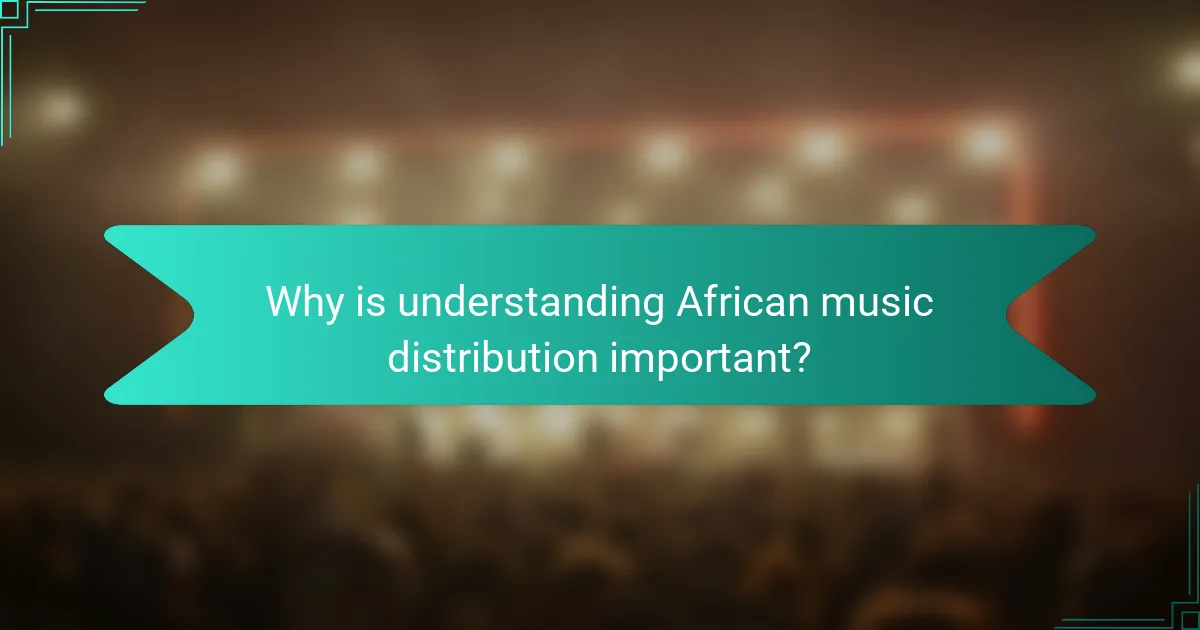
Why is understanding African music distribution important?
Understanding African music distribution is important because it influences the accessibility and promotion of diverse musical genres. This distribution shapes how artists reach audiences both locally and globally. Knowledge of distribution channels helps artists maximize their reach and revenue. In Africa, unique challenges exist such as limited infrastructure and varying digital access. For instance, streaming platforms may not be widely used in all regions. Moreover, understanding these dynamics can lead to better support for local artists. It can also foster cultural exchange and appreciation. Ultimately, effective distribution enhances the sustainability of the African music industry.
What are the economic impacts of music distribution in Africa?
Music distribution in Africa significantly impacts the economy by creating revenue streams for artists and the industry. It enhances job creation through various roles in production, marketing, and distribution. The digital distribution model has expanded access to global markets, increasing sales potential. According to the International Federation of the Phonographic Industry (IFPI), Africa’s recorded music market grew by 8.6% in 2020. This growth is driven by increased internet [censured] and mobile access. Furthermore, local music consumption fosters cultural tourism, contributing to national economies. Music festivals and events also generate income for local businesses. Overall, music distribution in Africa plays a crucial role in economic development and cultural exchange.
How does music distribution influence local economies?
Music distribution significantly influences local economies by creating jobs and generating revenue. It supports local artists, enabling them to earn income through sales and performances. Increased visibility of local music can attract tourism, further boosting local businesses. Music distribution platforms often invest in community initiatives, enhancing local cultural scenes. For instance, a study by the International Federation of the Phonographic Industry (IFPI) highlights that music contributes over $70 billion to the global economy annually. This economic activity is reflected at local levels through increased spending in related sectors, such as hospitality and retail.
What role does music play in cultural identity and expression?
Music serves as a vital component of cultural identity and expression. It reflects the values, beliefs, and traditions of a community. Through music, individuals communicate their heritage and shared experiences. This is evident in various African musical genres, which often incorporate local languages and instruments. For example, the use of traditional drums in ceremonies signifies cultural rituals and storytelling. Studies show that music fosters a sense of belonging among community members. It also plays a role in social movements, uniting people for common causes. Furthermore, music can preserve history, passing down knowledge through generations. Thus, music is essential in defining and expressing cultural identity.
How can artists navigate the distribution landscape effectively?
Artists can navigate the distribution landscape effectively by leveraging digital platforms. These platforms include streaming services, social media, and online marketplaces. Utilizing platforms like Spotify and Apple Music increases visibility. Engaging with fans through social media fosters community and loyalty. Collaborating with local distributors can enhance reach within specific regions. Understanding copyright laws is crucial for protecting their work. Data analytics from these platforms can inform marketing strategies. Artists should prioritize building a strong online presence to attract audiences.
What strategies can artists use to maximize their reach?
Artists can maximize their reach by leveraging social media platforms effectively. These platforms allow for direct engagement with fans and broader audience exposure. Regularly posting content increases visibility and interaction. Collaborating with other artists can introduce them to new audiences. Utilizing streaming services enhances accessibility to their music. Engaging in live performances can build a loyal fanbase. Networking with industry professionals opens up new opportunities. Participating in music festivals can showcase their work to diverse crowds. Each of these strategies contributes to expanding an artist’s reach in the competitive music landscape.
How can collaboration with distributors enhance visibility?
Collaboration with distributors enhances visibility by expanding market reach. Distributors have established networks that connect artists to a broader audience. They utilize various platforms and channels to promote music effectively. This partnership allows for targeted marketing strategies tailored to specific demographics. Increased presence on streaming services and retail outlets boosts discoverability. Additionally, distributors often provide valuable insights into market trends and consumer preferences. This data can inform promotional efforts and content creation. Overall, collaboration fosters a more significant impact in the competitive music landscape.
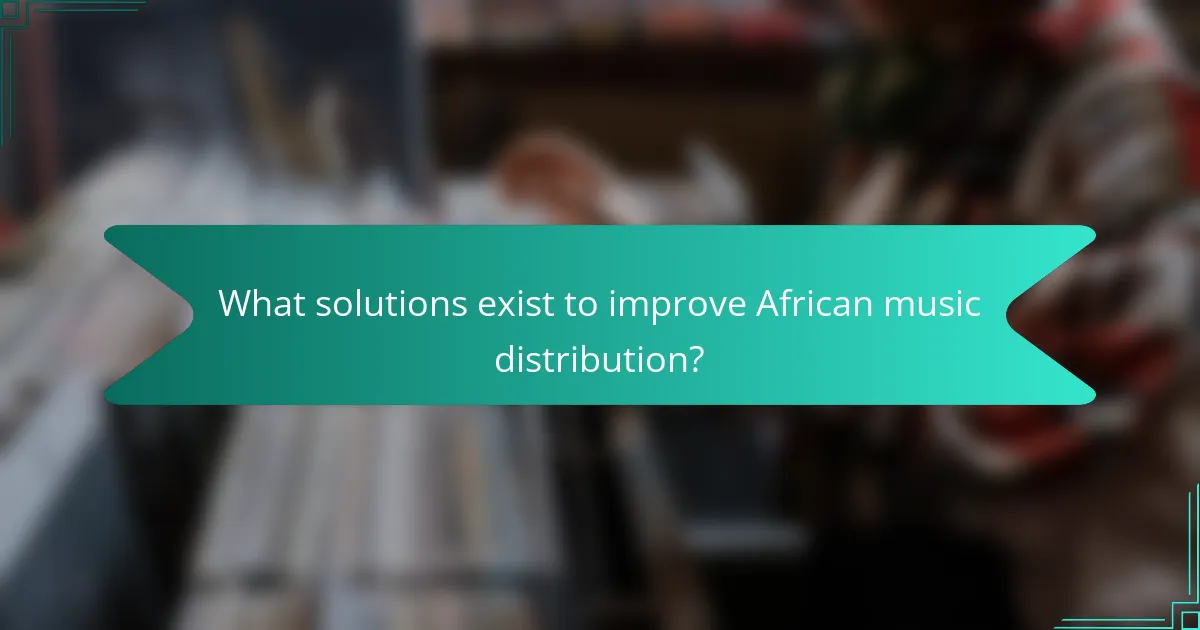
What solutions exist to improve African music distribution?
Digital platforms enhance African music distribution. They provide wider reach and accessibility for artists. Services like Spotify and Apple Music enable global streaming. Local platforms, such as Boomplay, cater specifically to African audiences. Improved internet connectivity boosts digital music consumption. Mobile payment systems facilitate easier transactions for artists. Collaborations with international labels expand market opportunities. Music festivals and events increase visibility for local talent. These solutions collectively address distribution challenges in the African music industry.
What innovative approaches are being implemented in the industry?
Digital distribution platforms are revolutionizing African music distribution. These platforms allow artists to reach global audiences easily. They enable streaming and direct sales, increasing revenue opportunities. Blockchain technology is also being explored for transparent royalty payments. This approach ensures that artists receive fair compensation for their work. Additionally, mobile payment systems are facilitating transactions in regions with limited banking infrastructure. These innovations are addressing challenges in traditional distribution methods. They enhance accessibility and efficiency in the music industry.
How can technology facilitate better distribution channels?
Technology can facilitate better distribution channels by streamlining processes and enhancing connectivity. Digital platforms allow for real-time tracking of shipments. This leads to increased transparency in the supply chain. Automated systems can optimize inventory management, reducing delays. Cloud-based solutions enable collaboration among stakeholders, improving communication. Data analytics provide insights into consumer preferences, guiding distribution strategies. Mobile applications can facilitate direct sales, reaching customers more effectively. According to a report by McKinsey, companies using technology in logistics can reduce costs by up to 30%. This demonstrates the significant impact technology can have on improving distribution efficiency.
What role do community initiatives play in supporting artists?
Community initiatives play a crucial role in supporting artists by providing resources and platforms for collaboration. These initiatives often create local networks that foster artistic development. They can offer financial support through grants and funding opportunities. Additionally, community initiatives organize events that showcase artists’ work. This visibility can lead to increased recognition and sales for artists. Furthermore, they facilitate mentorship programs connecting emerging artists with established professionals. Research indicates that community support enhances artistic innovation and sustainability. For example, initiatives like local art festivals have significantly boosted artists’ careers in various regions.
What best practices can artists adopt for successful distribution?
Artists can adopt several best practices for successful distribution. First, they should utilize digital distribution platforms like DistroKid or TuneCore. These platforms help artists reach global audiences efficiently. Next, artists should engage actively on social media to promote their music. This engagement builds a loyal fan base that can drive sales and streams.
Additionally, collaborating with other artists can expand their reach. Collaborative projects introduce artists to each other’s audiences. Artists should also focus on high-quality visuals and branding. Strong branding helps in creating a memorable identity.
Finally, understanding analytics from streaming platforms is crucial. Analyzing data helps artists make informed decisions about their marketing strategies. By implementing these practices, artists can enhance their distribution success.
How can understanding target audiences improve distribution efforts?
Understanding target audiences enhances distribution efforts by ensuring content reaches the right people. Tailoring messaging and channels to audience preferences increases engagement. For example, research shows that targeted marketing can improve response rates by up to 50%. Knowing demographics helps in selecting appropriate platforms for distribution. This leads to optimized resource allocation and cost savings. Accurate audience insights also inform timing for releases, maximizing impact. Ultimately, understanding target audiences leads to more effective and efficient distribution strategies.
What are the key considerations when choosing distribution platforms?
Key considerations when choosing distribution platforms include reach, cost, and user interface. Reach refers to the platform’s ability to connect with target audiences. Platforms with a wider distribution network can increase visibility. Cost involves fees associated with using the platform, which can impact profitability. User interface affects ease of use for artists and labels. A straightforward interface facilitates better management of music releases. Additionally, the platform’s reputation influences trust and reliability. Research shows that artists prefer platforms with a strong track record in the industry. These factors collectively ensure effective distribution of music.
The main entity of the article is African music distribution, which encompasses the logistics and processes involved in delivering music to audiences both locally and globally. The article examines key components such as digital and physical distribution channels, the role of record labels, and the impact of technology on the music landscape. It highlights challenges faced in Africa, including limited infrastructure, legal hurdles, and inconsistent internet access, while also discussing innovative solutions and strategies for artists to enhance their reach. Additionally, the economic implications of music distribution and its significance in cultural identity are explored, providing a comprehensive overview of the current state and future prospects of the African music industry.
